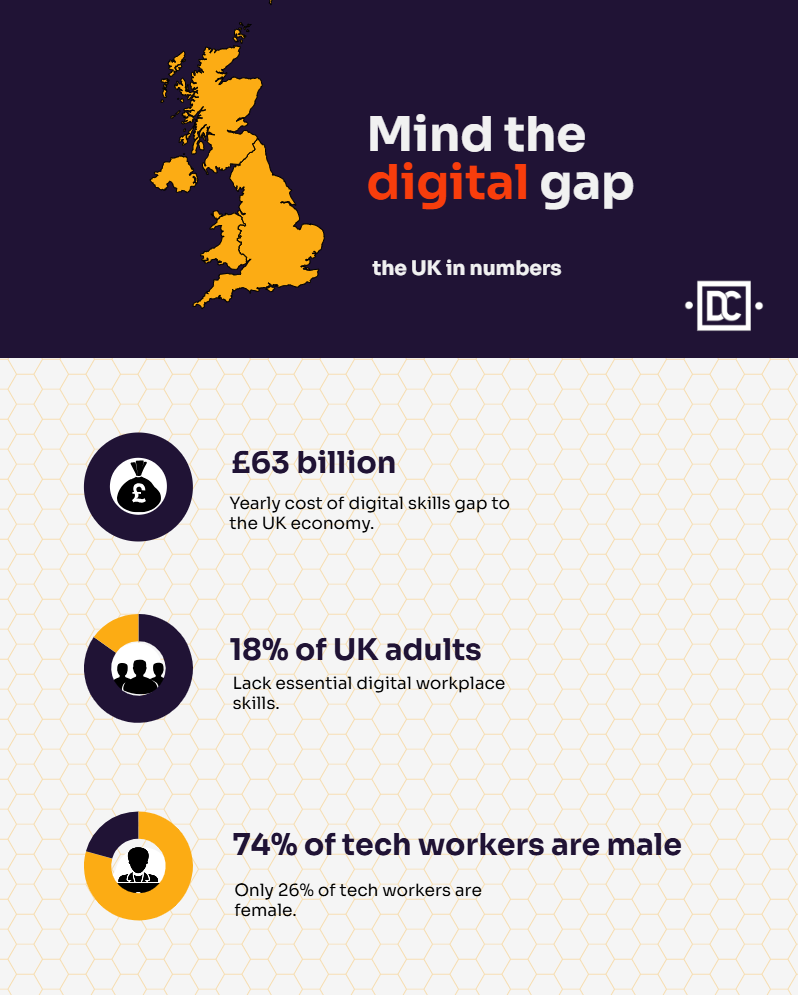I’ve been reading about how the digital skills gap is affecting world economies for years now, yet nothing seems to change. That isn’t likely to improve anytime soon in the UK. In their 2024 Workforce of the Future report, Hays Recruitment found the UK has the third largest technology talent deficit in its global review.
In a situation where technology is changing faster than the school or university curricula can keep pace with, this isn’t surprising. Even if they were able to adapt faster, by the time your staff are recruited and onboarded they will still be playing catch up.
So the real question is, what can we do about it? Well my answer would be that we need to start training our own talent instead, so let’s take a look at why.
How big is the digital skills gap?
In short, pretty big. A recent House of Commons report estimated the cost of the digital skills gap at £63 billion per year.
Computer science is now a compulsory subject for pupils up to the age of 16 in schools, with the emphasis shifting to encourage developmental thinking. Although this is a positive move, in practice it is hard to implement when skilled IT specialists are in such high demand elsewhere. Essentially, business is outbidding education when it comes to salary and it’s having a knock-on effect throughout the skills chain.
This problem is worsened by the massive gender difference in computer science training. A 2022 Ofsted report found a consistent lack of qualified computing teachers across schools, unsurprising considering that only 15% of girls take an A level in computer science, yet women make up 76% of classroom teachers.


Want to knock out your competitors?
How you can bridge the IT skills gap
Sadly, there are no silver bullets for a quick fix but there are options that can help in both the short and long term. The important thing is to develop and implement plans that will secure your business growth and security.
Short term
Freelancers:
Nobody wants to be fully reliant on freelance IT talent, particularly in industries such as SaaS, Fintech and Defense, where costly background checks have to be carried out for each employee. However, if you can build up a relationship with someone with specific skills and provenance, this can help inject the quality and knowledge that you need. This is particularly useful for specific projects where you have defined parameters.
Consultants:
Businesses can be surprisingly unimaginative when it comes to consultants. It’s easy to limit thinking to areas such as business strategy or Marketing. Instead, consider investing in outside help to bolster your infrastructure, such as building internal training schemes, onboarding courses and e-learning libraries. This type of closed-ended pieces of work will provide long term value and quantifiable ROI in time saved.
Placements and internships:
If you choose your candidates carefully, these can be the ultimate in win-win scenarios. A free or low cost option, placements can provide you with an employee who is keen both to learn and share knowledge whilst gaining valuable work experience.
In practice, I have seen this result in everything from improved workflows because of the insight that a fresh pair of eyes can bring, to suggestions of alternative methods of handling Marketing channels and campaigns.


Want to add a touch of magic to your content?
Long term
Mentoring schemes
A lot of companies balk at the idea of this because it means that anyone acting as mentor takes time out of their day and away from the main focus of their role. Essentially, it slows down the mentor and makes them less productive. Although this is true, in the long term it is often more cost-effective than buying in role-ready external hires.
If we use a football analogy, it’s the difference between nurturing talent in your youth team and buying in a player from the transfer list. Managed properly, this approach provides you with a stable of home-grown talent that you already know the measure of. It can range from going in to schools to give talks or lessons and talent spotting, through to taking on graduates who haven’t yet got the x years of experience that so many job vacancies ask for.
Employees who grow with you are more likely to have an understanding of your business needs and how emerging tech can meet them. They are often extremely loyal and make extremely agile employees.
In-house training courses
Many SaaS company employees have a more fluid career path than employees in traditional industries or manufacturing. Someone who starts life in customer service may well move across to a tech team, for example.
Providing training courses in-house can be a fantastic way to upskill existing employees and allow them to flourish. They already know your company and its culture and this is an additional incentive to stay – always a cheaper option than recruiting and onboarding externally.
These courses don’t have to be live, they can be created as stand alone e-learning modules with quizzes and certificates at the end or as part of a hybrid offering.
AI
If you put the time in to create the workflows, AI can help you cut down on hours spent performing time-consuming and repetitive tasks. If you think about how much time could be saved by something as simple as automated email responses it will give you an inkling of what could be achieved with everything from Sales forecasting to predictive maintenance or invoicing.
One word of caution. Even if you are a SaaS business, don’t be that company that tells its employees to get to grips with AI and then leaves it at that. Not everybody will have the confidence to do that or the imagination to understand how to apply it within their role. Do everything possible to foster cross-departmental projects to identify hit list areas and encourage and reward the resulting achievements.
Final thoughts
Creating what Amazon calls a ‘learn and be curious’ culture is a great way of attracting and retaining talented employees. Knowing that continuous learning is encouraged and that opportunities for development are offered gives you a competitive advantage. It is also a way of ensuring innovation is part of your future and that your employees are equipped to handle it.
There will always be some individuals who will move for a salary hike but for most people, if they are happy where they work and are earning a reasonable salary, they won’t even be looking at what else is out there.
When there’s a shortage of skilled people available, I believe that you should back yourself, which is really what offering proper training implies.
Dewar Creative specialises in creating brand-specific content for SaaS businesses. Click to find out how I can help with your content needs.
Sources
House of Commons Science and Technology Committee: Digital skills crisis
House of Commons Library: Digital skills and careers
BCS The Chartered Institute for IT: State of the nation report 2022

